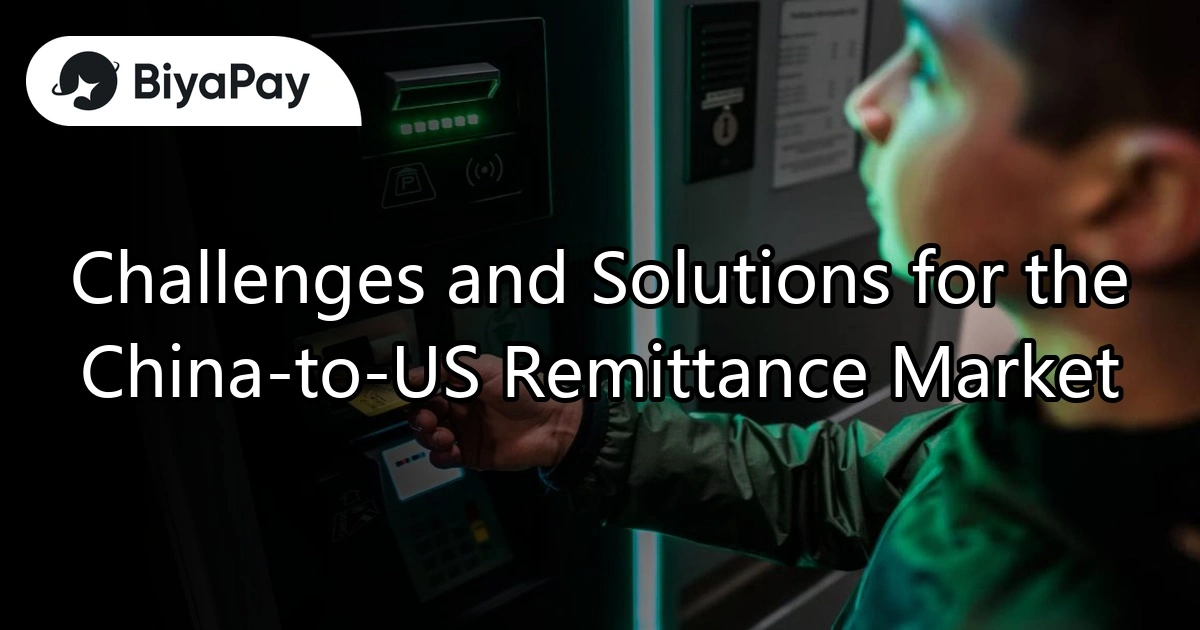- EasyCard
- Trade
- Help
- Announcement
- Academy
- SWIFT Code
- Iban Number
- Referral
- Customer Service
- Blog
- Creator
Challenges and Solutions for the China-to-US Remittance Market

Image Source: pexels
In recent years, the China-to-US remittance market has faced numerous challenges, with exchange rate fluctuations being particularly significant. The instability of the CNY-to-USD exchange rate directly impacts the cost and amount of cross-border remittances. Businesses and individuals often incur additional fees due to exchange rate changes during remittances, increasing their financial burden. Additionally, policy restrictions and rising transaction costs have put pressure on the market. How to effectively address these issues has become a focal point for market participants.
Trends in CNY-to-USD Exchange Rate Changes in 2025

Image Source: pexels
Impact of the Global Economic Environment
The global economic environment has a significant impact on CNY-to-USD exchange rate fluctuations. In 2025, the uneven global economic recovery may exacerbate exchange rate volatility. Monetary policy adjustments by major economies, such as expectations of US interest rate hikes, directly affect international market confidence in the CNY. Additionally, changes in international crude oil prices are an important factor influencing exchange rates. Rising oil prices may increase pressure on China’s trade balance, leading to CNY depreciation.
- As of the end of April 2025, China’s foreign exchange reserves reached USD 3.2817 trillion, an increase of USD 41 billion from the end of March, representing a 1.27% rise.
- Since 2025, China’s foreign exchange reserves have shown growth for four consecutive months, with a cumulative increase of USD 79.3 billion.
- In April, the US dollar index fell by approximately 4.4%, driving up the prices of non-US dollar assets and further increasing the scale of foreign exchange reserves.
These data indicate that changes in the global economic environment not only affect the CNY exchange rate but also have a positive impact on China’s foreign exchange reserves.
Role of China’s Domestic Economic Policies
China’s economic policies play a key role in stabilizing the CNY exchange rate. By adjusting monetary policies and promoting consumption, the Chinese government strives to maintain basic exchange rate stability. In the first three quarters of 2024, the consumption propensity of urban residents reached 62%, higher than the 61.7% in the same period of 2023. It is expected that consumption propensity will further increase in 2025, providing support for the CNY exchange rate.
| Research Title | Key Findings |
|---|---|
| CNY Exchange Rate Fluctuations and Chinese Economic Growth: An Empirical Study Based on State-Space Models and Mediation Effect Tests | CNY real effective exchange rate depreciation has a positive impact on economic growth through the mediating effect of real export volumes. |
| Li Weiwu. Real Exchange Rates and Economic Growth: Evidence from China | CNY real exchange rate depreciation has played a positive role in promoting China’s economic growth. |
| Gu Yu, Gao Tiemei. Analysis of the Impact of CNY Exchange Rate Volatility on China’s Imports and Exports | CNY exchange rate depreciation has a significant positive impact on exports, promoting economic growth. |
| Li Jianwei, Yu Ming. Fluctuations in the CNY Effective Exchange Rate and Its Impact on China’s Economic Growth | CNY effective exchange rate depreciation has a significant positive impact on China’s economic growth. |
These studies show that changes in the CNY exchange rate are closely related to China’s economic policies. Through policy adjustments, China can effectively address the challenges posed by exchange rate fluctuations.
Impact of Federal Reserve Monetary Policy
The Federal Reserve’s monetary policy has a significant impact on the CNY-to-USD exchange rate. In 2025, expectations of US interest rate hikes may strengthen the US dollar, putting pressure on the CNY exchange rate. Meanwhile, the People’s Bank of China’s policy aims to maintain basic CNY exchange rate stability, enhancing market confidence in the CNY.
- The correlation between the CNY and traditional risk currencies has decreased, while its correlation with safe-haven currencies has increased, indicating the CNY’s safe-haven characteristics during market volatility.
- Recent fluctuations in the CNY exchange rate have shown a reduced correlation with domestic and international risk assets, suggesting changes in market confidence in the CNY.
By observing these trends, it can be seen that the Federal Reserve’s monetary policy adjustments not only affect the strength of the US dollar but also indirectly influence the CNY’s market performance. China addresses external pressures through prudent policies, providing assurance for CNY exchange rate stability.
Main Factors Affecting the CNY-to-USD Exchange Rate
International Trade and Capital Flows
International trade and capital flows have a critical impact on the CNY-to-USD exchange rate. An expanding trade surplus typically increases demand for the CNY, driving its appreciation. Conversely, a trade deficit may lead to CNY depreciation. Capital flows directly affect the exchange rate through cross-border investments and fund transfers.
After the August 11, 2015 exchange rate reform, market expectations of CNY depreciation triggered large-scale capital outflows. This phenomenon was particularly evident in 2016, when foreign exchange reserves significantly decreased, reflecting the severity of capital outflows. Data on bank foreign exchange settlements and cross-border payments also show this trend. Changes in capital flows not only affect the supply-demand balance in the foreign exchange market but also have a profound impact on CNY exchange rate stability.
Additionally, the direction and scale of cross-border capital flows are influenced by international investor confidence. Investors’ views on China’s economic prospects directly affect capital inflows or outflows. A stable economic environment and policy support help attract more capital inflows, thereby supporting the CNY exchange rate.
Impact of Geopolitical Events
Geopolitical events often have an indirect impact on the CNY-to-USD exchange rate. International conflicts, trade frictions, and changes in regional economic cooperation can alter market expectations for the CNY. For example, adjustments in global supply chains may affect China’s export competitiveness, putting pressure on the CNY exchange rate.
Deepening regional economic cooperation can enhance the CNY’s international status. By signing free trade agreements with other countries, China can expand trade volumes and increase the CNY’s usage scope. This trend helps enhance CNY stability and reduces the negative impact of geopolitical events.
Market Sentiment and Investor Behavior
Market sentiment and investor behavior play a significant role in exchange rate fluctuations. Investors’ risk preferences and judgments about future economic trends directly affect CNY demand. For instance, when markets are pessimistic about global economic prospects, investors may prefer holding safe-haven assets like the US dollar, leading to CNY depreciation.
On the other hand, investor confidence in China’s economic policies also affects the CNY exchange rate. If the market believes China’s policies can effectively address external challenges, the CNY may be supported. Conversely, policy uncertainty may trigger market panic, exacerbating CNY exchange rate volatility.
Changes in market sentiment are typically reflected through trading volumes and price fluctuations. The complexity of investor behavior makes exchange rate predictions more challenging, but observing market trends can provide a better understanding of CNY exchange rate patterns.
Specific Challenges in the China-to-US Remittance Market

Image Source: pexels
Cost Increases Due to Exchange Rate Fluctuations
The impact of exchange rate fluctuations on the China-to-US remittance market is evident. CNY depreciation against the US dollar directly increases remittance costs, especially for businesses paying for imported goods. For example, the import cost of US agricultural products like soybeans has risen significantly due to CNY depreciation, affecting domestic market price levels. Additionally, exchange rate changes have a profound impact on businesses’ import and export operations:
- When the CNY depreciates, export businesses may see increased revenue, but import businesses face significantly higher costs.
- Transportation costs also rise due to exchange rate fluctuations, further increasing businesses’ financial burdens.
For individuals, exchange rate fluctuations may reduce the actual value of remitted amounts, especially during periods of exchange rate instability. This uncertainty creates greater economic pressure for individuals and businesses conducting cross-border remittances.
Complexity of Risk Management
Cross-border remittances involve various risk management issues, particularly in the China-to-US remittance market. Payment institutions and platform economy entities face complex compliance requirements and regulatory challenges. According to statistics, from 2013 to 2022, the US Office of Foreign Assets Control (OFAC) executed 164 enforcement cases against non-bank payment institutions and digital economy platform companies, with total fines amounting to approximately USD 3.499 billion. Among these, sample companies in the payment industry were fined USD 1,041,752, accounting for 0.30% of the total fines.
The complexity of risk management is mainly reflected in the following aspects:
- Model Risk Identification: Identifying potential risks associated with each model.
- Model Risk Assessment: Assessing risks through quantitative and qualitative methods and proposing a rating system.
- Model Risk Mitigation: Developing strategies to address risk sources.
- Model Monitoring and Governance: Continuously monitoring model performance and establishing effective oversight systems.
While these measures help businesses reduce risks, they also increase management costs and operational complexity. For small and medium-sized enterprises, the lack of professional risk management teams may further exacerbate this issue.
Limitations on Remittance Speed and Efficiency
Although cross-border remittance speeds have improved in recent years, efficiency limitations persist. According to Swift data, 89% of cross-border remittances can be completed within one hour, indicating improvements in clearing efficiency. However, some remittances still take days or even a month to complete. Such delays can adversely affect the liquidity of funds for businesses and individuals.
The time costs of different remittance methods vary significantly. For example:
| Remittance Method | Time Cost |
|---|---|
| Traditional Cross-Border Payment Model | At least 24 hours |
| Blockchain-Based Payment | Near “real-time,” 7×24 uninterrupted service |
With the development of the digital economy, cross-border transfer times have been reduced from 2-3 days to seconds. In 2023, global real-time payment transactions reached 266.2 billion, a year-on-year increase of 42.2%. By 2028, instant payments are expected to account for 42% of cross-border payment transaction volumes, with a total value of USD 16 trillion. However, for the China-to-US remittance market, the efficiency of some traditional payment methods remains low, limiting the rapid flow of funds.
Solutions to Address Challenges in the China-to-US Remittance Market
Using Financial Tools to Lock Exchange Rates
The use of financial tools can effectively mitigate risks from exchange rate fluctuations. Businesses and individuals can lock exchange rates through tools such as forex options, forward contracts, and interest rate swaps, ensuring predictable remittance costs. For example, a trading company purchased a 6-month USD call option with a strike price of 6.8, avoiding risks from future exchange rate fluctuations. Additionally, a company hedged CNY depreciation risks through forex futures contracts, ultimately profiting USD 1.76 million in the futures market. These cases demonstrate the significant effectiveness of financial tools in addressing exchange rate fluctuations.
In recent years, China’s forex and currency swap markets have been active, with an average monthly trading volume of USD 823.8 billion. This data reflects the growing market demand for financial tools. By selecting and using these tools appropriately, businesses and individuals can better manage exchange rate risks in the China-to-US remittance process.
Optimizing Remittance Timing
Choosing the right remittance timing is a key strategy for reducing costs. Businesses and individuals can analyze exchange rate fluctuation trends and select times when exchange rates are more favorable for remittances. For example, a service center helped businesses develop hedging strategies by simulating real exchange rate fluctuation scenarios. As of May 2025, the center has served over 400 businesses and facilitated 10 companies in completing their first derivative product contracts. These data show that optimizing remittance timing can significantly improve the success rate of actual remittances.
Additionally, dynamically updated service plans can provide more targeted recommendations based on businesses’ operational characteristics and needs. This flexibility enables businesses to better control remittance costs in complex market environments.
Policy Recommendations and Improvements in Market Regulation
Improving policies and regulations is crucial for the stable development of the China-to-US remittance market. The government can enhance market regulation to ensure the transparency and security of cross-border remittances. For example, optimizing foreign exchange management policies and simplifying remittance processes can effectively improve remittance efficiency. Additionally, encouraging financial institutions to develop more innovative products can provide businesses and individuals with diverse options.
Financial institutions such as Hong Kong banks can play a significant role in this process. By offering more efficient clearing services and flexible exchange rate locking tools, these institutions can help clients better address market challenges. Policy improvements and market innovations will lay a solid foundation for the long-term development of the China-to-US remittance market.
The trend of CNY-to-USD exchange rate changes in 2025 is influenced by multiple factors. Events such as China’s reduction of the reserve requirement ratio and loose monetary policies by major global economies have significantly impacted exchange rate fluctuations. Below is some statistical data:
| Time | CNY-to-USD Exchange Rate Range | Main Influencing Factors |
|---|---|---|
| May 2025 | 7.1722 to 7.2461 | China’s reduction of the reserve requirement ratio, outcomes of the Geneva China-US trade talks, Moody’s downgrade of US credit rating, rising Japanese government bond yields, etc. |
| June 2025 | 7.0–7.3 | Policy uncertainty under the Trump administration, loose monetary policies by major global economies, inflation concerns due to US high-tariff policies, etc. |
The challenges facing the China-to-US remittance market include exchange rate fluctuations, rising costs, and efficiency limitations. By using financial tools to lock exchange rates, optimizing remittance timing, and improving policies, market participants can effectively address these issues.
In the future, with advancements in digital payment technologies and further policy optimizations, the cross-border remittance market will become more efficient and stable. The internationalization of the CNY will also bring more opportunities to the remittance market. Market participants should seize these trends and formulate flexible strategies to navigate the evolving economic environment.
FAQ
What are the main cost components of China-to-US remittances?
The main costs of China-to-US remittances include exchange rate spreads, handling fees, and potential intermediary bank fees. Exchange rate fluctuations may increase remittance costs, especially during market instability. Choosing the right remittance method and timing can effectively reduce these costs.
How to choose the most suitable remittance method?
When choosing a remittance method, consider factors such as transfer speed, fees, and exchange rate benefits. Traditional banks are suitable for large remittances, while digital payment platforms are better for small, fast remittances. Select the optimal solution based on your needs.
How do exchange rate fluctuations affect individual remittances?
Exchange rate fluctuations may reduce the actual value of remitted amounts. For example, when the CNY depreciates, the amount received in the US decreases. Using financial tools to lock exchange rates can mitigate this impact.
How to ensure the security of cross-border remittances?
Choosing reputable remittance institutions is key to ensuring security. Verify the institution’s credentials and avoid using platforms from unknown sources. Comply with relevant regulations to ensure the legitimacy of fund sources.
How does digital payment technology improve China-to-US remittances?
Digital payment technologies significantly enhance remittance speed and efficiency. Blockchain-based payment methods enable real-time transfers, reducing the time costs of traditional payments. In the future, digital payments will further optimize user experiences.
The 2025 China-to-U.S. remittance market faces challenges from exchange rate volatility (7.0-7.3), high costs (5-15%), and complex compliance, burdening businesses and individuals. BiyaPay offers efficient, low-cost cross-border remittance solutions, supporting conversions across 30+ fiat currencies and 200+ cryptocurrencies with remittance fees as low as 0.5%, covering 190+ countries with same-day delivery. Whether for corporate import payments or personal transfers, BiyaPay’s real-time exchange rate tracking and advanced encryption ensure cost control and compliance. Join BiyaPay now to reduce remittance costs! You can also invest in U.S. and Hong Kong stocks directly on the BiyaPay platform without needing an additional overseas account, optimizing capital allocation. Idle funds can earn a 5.48% APY through current investment products, backed by BiyaPay’s U.S. MSB and SEC licenses. Sign up with BiyaPay to tackle remittance challenges and empower global business!
*This article is provided for general information purposes and does not constitute legal, tax or other professional advice from BiyaPay or its subsidiaries and its affiliates, and it is not intended as a substitute for obtaining advice from a financial advisor or any other professional.
We make no representations, warranties or warranties, express or implied, as to the accuracy, completeness or timeliness of the contents of this publication.




Contact Us
Company and Team
BiyaPay Products
Customer Services
is a broker-dealer registered with the U.S. Securities and Exchange Commission (SEC) (No.: 802-127417), member of the Financial Industry Regulatory Authority (FINRA) (CRD: 325027), member of the Securities Investor Protection Corporation (SIPC), and regulated by FINRA and SEC.
registered with the US Financial Crimes Enforcement Network (FinCEN), as a Money Services Business (MSB), registration number: 31000218637349, and regulated by FinCEN.
registered as Financial Service Provider (FSP number: FSP1007221) in New Zealand, and is a member of the Financial Dispute Resolution Scheme, a New Zealand independent dispute resolution service provider.


















